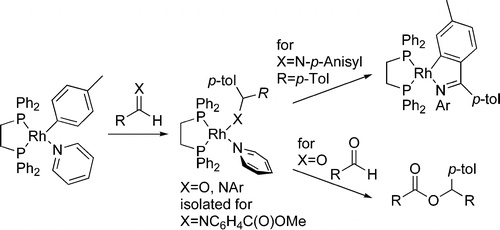Reactions of an Arylrhodium Complex with Aldehydes, Imines, Ketones, and Alkynones. New Classes of Insertion Reactions

Organorhodium complexes of the general formula (DPPE)Rh(pyridine)(R) (R = p-tol (2a) and CH2SiMe3 (2b), DPPE = 1,2-bis(diphenylphosphino)ethane) were prepared from [(DPPE)Rh(μ-Cl)]2, pyridine, and p-tolyllithium or Me3SiCH2MgCl. Complex 2a inserted the electron-poor aldimines (p-tol)CH N(C6H4-p-CO2Me) (3a-Tol) and (Ph)CH
N(C6H4-p-CO2Me) (3a-Tol) and (Ph)CH N(C6H4-p-CO2Me) (3a-Ph) to give amide complexes that were isolated directly or trapped with PEt3. In contrast, the reaction of aryl complex 2a with the electron-neutral and electron-rich imines PhCH
N(C6H4-p-CO2Me) (3a-Ph) to give amide complexes that were isolated directly or trapped with PEt3. In contrast, the reaction of aryl complex 2a with the electron-neutral and electron-rich imines PhCH NPh (3b) and (p-tol)CH
NPh (3b) and (p-tol)CH N(C6H4-p-OMe) (3c) did not form stable amide products. Instead, the amide from insertion of imines 3b or 3c underwent β-hydrogen elimination, followed by metalation of the resulting ketimine. The reaction of 2a with 3a-Ph was first order in arylrhodium complex and inverse first order in the concentration of pyridine. Aldehydes that cannot enolize, such as PhCHO and Me3CCHO, inserted into the Rh−aryl bond of 2a to form ketones and esters. The esters were formed from insertion of a second aldehyde into the Rh−O bond of an intermediate alkoxide, followed by β-hydride elimination. Complex 2a underwent proton transfer with acetophenone to give π-oxaallyl complex 24 and with water to generate toluene and the dimeric hydroxide [(DPPE)Rh(μ-OH)]2 (36). It also reacted with the tert-butyl-substituted ynone 25 to form a product that contained a metalated isobutyl group. Quenching the reaction between aryl complexes 2a and 3a-Ph with H2O instead of PEt3 also formed hydroxide 36 and the diarylmethylamine (Ph)(p-tol)CH−NH(C6H4-p-CO2Me) (35).
Read more on publisher's site.
N(C6H4-p-OMe) (3c) did not form stable amide products. Instead, the amide from insertion of imines 3b or 3c underwent β-hydrogen elimination, followed by metalation of the resulting ketimine. The reaction of 2a with 3a-Ph was first order in arylrhodium complex and inverse first order in the concentration of pyridine. Aldehydes that cannot enolize, such as PhCHO and Me3CCHO, inserted into the Rh−aryl bond of 2a to form ketones and esters. The esters were formed from insertion of a second aldehyde into the Rh−O bond of an intermediate alkoxide, followed by β-hydride elimination. Complex 2a underwent proton transfer with acetophenone to give π-oxaallyl complex 24 and with water to generate toluene and the dimeric hydroxide [(DPPE)Rh(μ-OH)]2 (36). It also reacted with the tert-butyl-substituted ynone 25 to form a product that contained a metalated isobutyl group. Quenching the reaction between aryl complexes 2a and 3a-Ph with H2O instead of PEt3 also formed hydroxide 36 and the diarylmethylamine (Ph)(p-tol)CH−NH(C6H4-p-CO2Me) (35).
Read more on publisher's site.